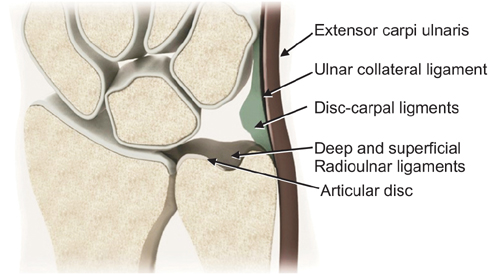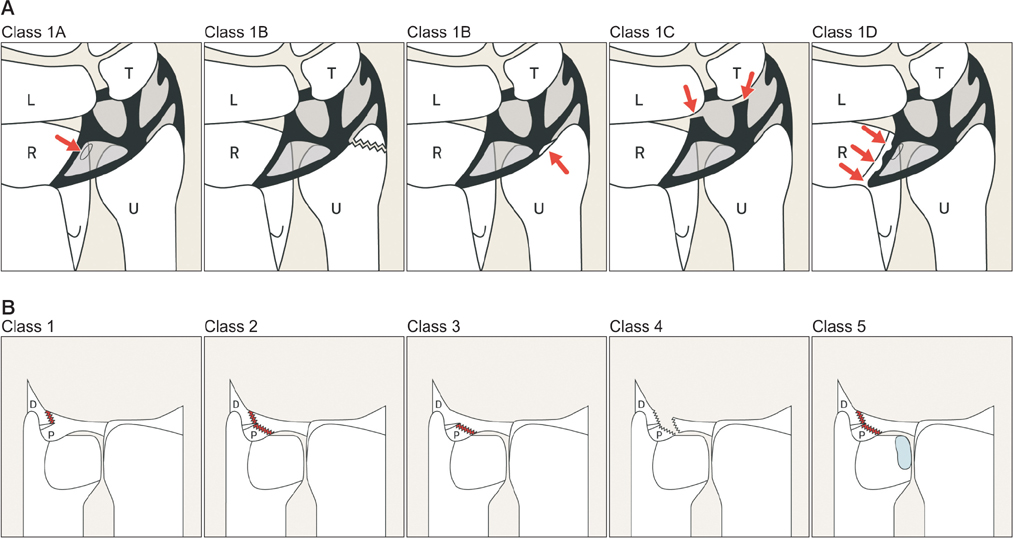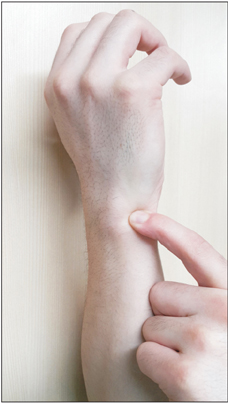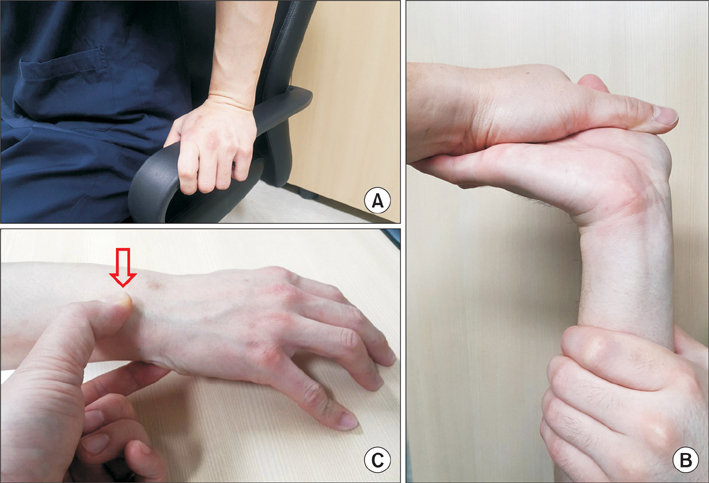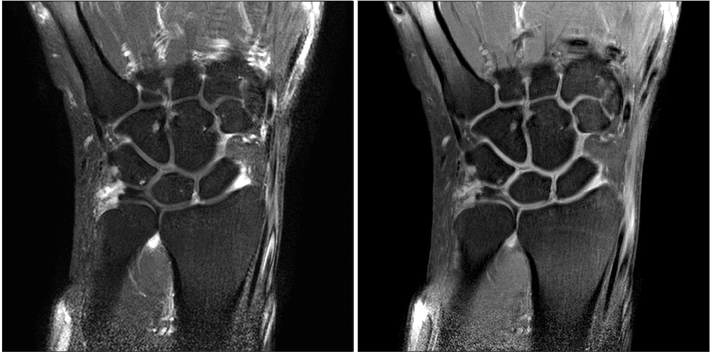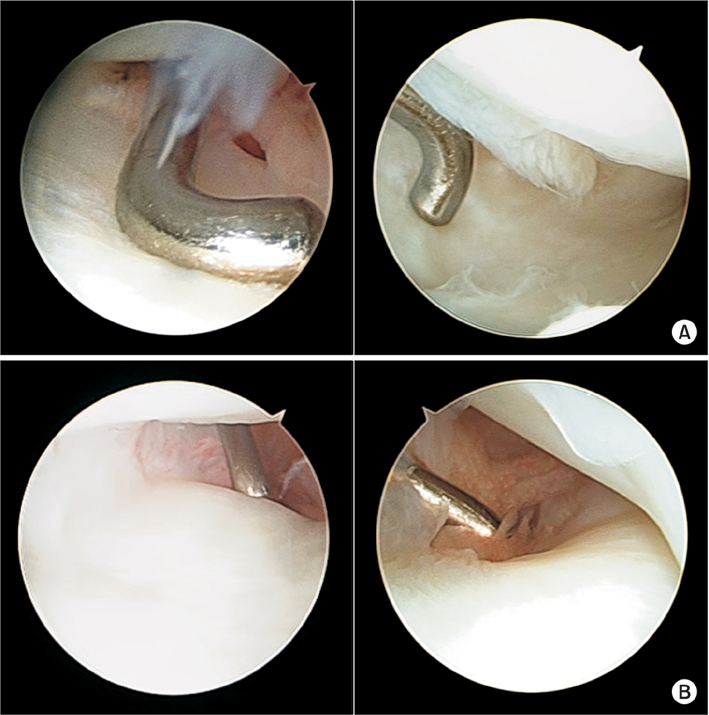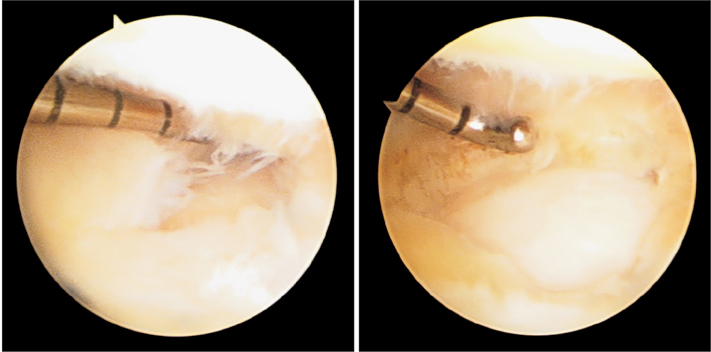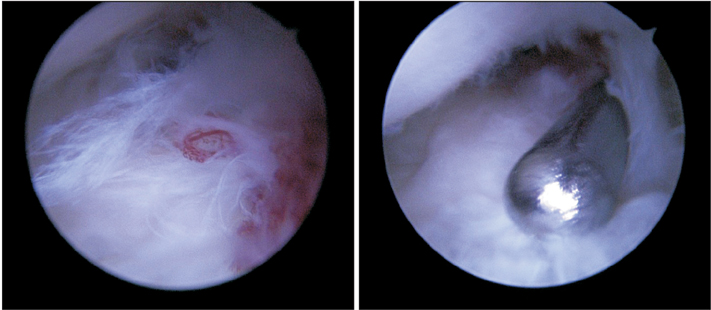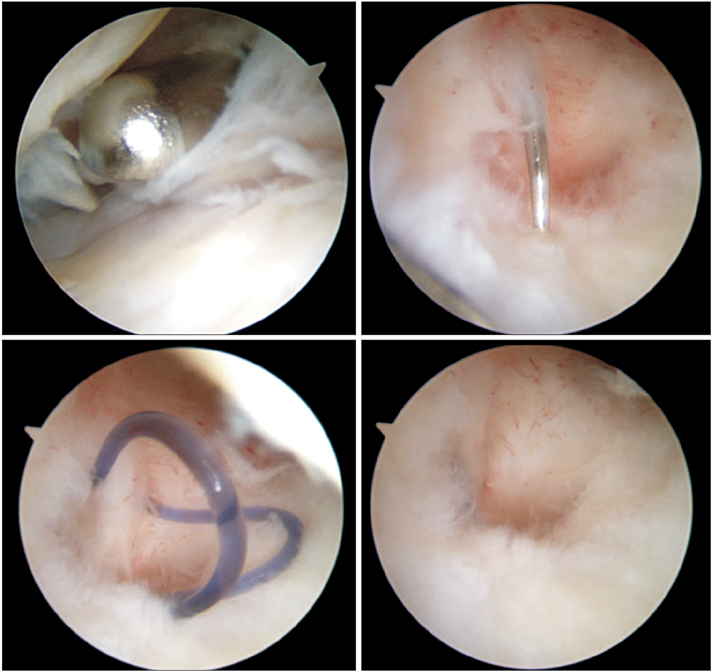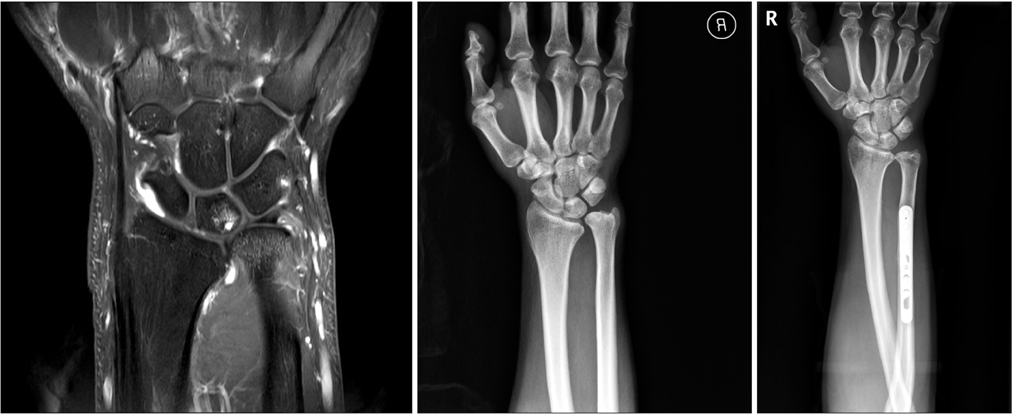J Korean Orthop Assoc.
2017 Apr;52(2):112-124. 10.4055/jkoa.2017.52.2.112.
Traumatic Triangular Fibrocartilage Complex Injuries and Instability of the Distal Radioulnar Joint
- Affiliations
-
- 1Department of Orthopaedic Surgery, Soonchunhyang University College of Medicine, Seoul, Korea. huuy@schmc.ac.kr
- KMID: 2438976
- DOI: http://doi.org/10.4055/jkoa.2017.52.2.112
Abstract
- Traumatic triangular fibrocartilage complex (TFCC) injuries require multidisciplinary approach and plan. Trauma to TFCC can lead to instability of the distal radioulnar joint (DRUJ). Injury to TFCC is classified as a stable type that does not cause unstable lesions for DRUJ or unstable type that can cause instability of DRUJ. According to the location and severity of the injury, arthroscopic debridement or arthroscopic repair may be considered. In the ulnar side avulsion of TFCC, which could cause DRUJ instability, arthroscopic examination should be performed to identify an accurate location of the damaged structures, followed by arthroscopic debridement and repair. In the event of TFCC and DRUJ injuries with ulnar positive variance, arthroscopic TFCC repair or ulnar shortening osteotomy after arthroscopic debridement could be considered to solve the instability and ulnar side pain. However, if peripheral TFCC tear with ulnar impaction syndrome and DRUJ instability, it combined operation of ulnar shortening osteotomy and TFCC foveal fixation could be considered. An accurate classification of TFCC and DRUJ injuries is necessary. It is important to resolve and prevent recurrence of ulnar wrist pain caused by instability.
MeSH Terms
Figure
Reference
-
1. Palmer AK, Werner FW. The triangular fibrocartilage complex of the wrist: anatomy and function. J Hand Surg Am. 1981; 6:153–162.2. Kim B, Yoon HK, Nho JH, et al. Arthroscopically assisted reconstruction of triangular fibrocartilage complex foveal avulsion in the ulnar variance-positive patient. Arthroscopy. 2013; 29:1762–1768.3. Abe Y, Moriya A, Tominaga Y, Yoshida K. Dorsal tear of triangular fibrocartilage complex: clinical features and treatment. J Wrist Surg. 2016; 5:42–46.4. Moritomo H. Open repair of the triangular fibrocartilage complex from palmar aspect. J Wrist Surg. 2015; 4:2–8.5. Atzei A, Luchetti R, Braidotti F. Arthroscopic foveal repair of the triangular fibrocartilage complex. J Wrist Surg. 2015; 4:22–30.6. Shinohara T, Tatebe M, Okui N, Yamamoto M, Kurimoto S, Hirata H. Arthroscopically assisted repair of triangular fibrocartilage complex foveal tears. J Hand Surg Am. 2013; 38:271–277.7. Khanchandani P, Badia A. Functional outcome of arthroscopic assisted fixation of distal radius fractures. Indian J Orthop. 2013; 47:288–294.8. Cardenas-Montemayor E, Hartl JF, Wolf MB, et al. Subjective and objective results of arthroscopic debridement of ulnar-sided TFCC (Palmer type 1B) lesions with stable distal radioulnar joint. Arch Orthop Trauma Surg. 2013; 133:287–293.9. Tang CY, Fung B, Rebecca C, Lung CP. Another light in the dark: review of a new method for the arthroscopic repair of triangular fibrocartilage complex. J Hand Surg Am. 2012; 37:1263–1268.10. Yamamoto M, Koh S, Tatebe M, et al. Importance of distal radioulnar joint arthroscopy for evaluating the triangular fibrocartilage complex. J Orthop Sci. 2010; 15:210–215.11. Wolf MB, Kroeber MW, Reiter A, et al. Ulnar shortening after TFCC suture repair of Palmer type 1B lesions. Arch Orthop Trauma Surg. 2010; 130:301–306.12. Stuart PR, Berger RA, Linscheid RL, An KN. The dorsopalmar stability of the distal radioulnar joint. J Hand Surg Am. 2000; 25:689–699.13. Kalainov DM, Culp RW. Arthroscopic treatment of TFCC tears. Tech Hand Up Extrem Surg. 1997; 1:175–182.14. Kihara H, Short WH, Werner FW, Fortino MD, Palmer AK. The stabilizing mechanism of the distal radioulnar joint during pronation and supination. J Hand Surg Am. 1995; 20:930–936.15. af Ekenstam F, Hagert CG. Anatomical studies on the geometry and stability of the distal radio ulnar joint. Scand J Plast Reconstr Surg. 1985; 19:17–25.16. Mino DE, Palmer AK, Levinsohn EM. The role of radiography and computerized tomography in the diagnosis of subluxation and dislocation of the distal radioulnar joint. J Hand Surg Am. 1983; 8:23–31.17. Skalski MR, White EA, Patel DB, Schein AJ, RiveraMelo H, Matcuk GR Jr. The traumatized TFCC: an illustrated review of the anatomy and injury patterns of the triangular fibrocartilage complex. Curr Probl Diagn Radiol. 2016; 45:39–50.18. Schmauss D, Pöhlmann S, Lohmeyer JA, Germann G, Bickert B, Megerle K. Clinical tests and magnetic resonance imaging have limited diagnostic value for triangular fibrocartilaginous complex lesions. Arch Orthop Trauma Surg. 2016; 136:873–880.19. Minami A. Triangular fibrocartilage complex tears. Hand Surg. 2015; 20:1–9.20. Hermansdorfer JD, Kleinman WB. Management of chronic peripheral tears of the triangular fibrocartilage complex. J Hand Surg Am. 1991; 16:340–346.21. Atzei A, Rizzo A, Luchetti R, Fairplay T. Arthroscopic foveal repair of triangular fibrocartilage complex peripheral lesion with distal radioulnar joint instability. Tech Hand Up Extrem Surg. 2008; 12:226–235.22. Ahn AK, Chang D, Plate AM. Triangular fibrocartilage complex tears: a review. Bull NYU Hosp Jt Dis. 2006; 64:114–118.23. Tay SC, Tomita K, Berger RA. The “ulnar fovea sign” for defining ulnar wrist pain: an analysis of sensitivity and specificity. J Hand Surg Am. 2007; 32:438–444.24. Henry MH. Management of acute triangular fibrocartilage complex injury of the wrist. J Am Acad Orthop Surg. 2008; 16:320–329.25. Nakamura R, Horii E, Imaeda T, Nakao E, Kato H, Watanabe K. The ulnocarpal stress test in the diagnosis of ulnar-sided wrist pain. J Hand Surg Br. 1997; 22:719–723.26. Lester B, Halbrecht J, Levy IM, Gaudinez R. “Press test” for office diagnosis of triangular fibrocartilage complex tears of the wrist. Ann Plast Surg. 1995; 35:41–45.27. Tomaino MM. The importance of the pronated grip x-ray view in evaluating ulnar variance. J Hand Surg Am. 2000; 25:352–357.28. Tay SC, Berger RA, Tomita K, Tan ET, Amrami KK, An KN. In vivo three-dimensional displacement of the distal radioulnar joint during resisted forearm rotation. J Hand Surg Am. 2007; 32:450–458.29. Nagle DJ, Benson LS. Wrist arthroscopy: indications and results. Arthroscopy. 1992; 8:198–203.30. Chung KC, Zimmerman NB, Travis MT. Wrist arthrography versus arthroscopy: a comparative study of 150 cases. J Hand Surg Am. 1996; 21:591–594.31. Iordache SD, Rowan R, Garvin GJ, Osman S, Grewal R, Faber KJ. Prevalence of triangular fibrocartilage complex abnormalities on MRI scans of asymptomatic wrists. J Hand Surg Am. 2012; 37:98–103.32. Potter HG, Asnis-Ernberg L, Weiland AJ, Hotchkiss RN, Peterson MG, McCormack RR Jr. The utility of high-resolution magnetic resonance imaging in the evaluation of the triangular fibrocartilage complex of the wrist. J Bone Joint Surg Am. 1997; 79:1675–1684.33. Tanaka T, Yoshioka H, Ueno T, Shindo M, Ochiai N. Comparison between high-resolution MRI with a microscopy coil and arthroscopy in triangular fibrocartilage complex injury. J Hand Surg Am. 2006; 31:1308–1314.34. Blazar PE, Chan PS, Kneeland JB, Leatherwood D, Bozentka DJ, Kowalchick R. The effect of observer experience on magnetic resonance imaging interpretation and localization of triangular fibrocartilage complex lesions. J Hand Surg Am. 2001; 26:742–748.35. Haims AH, Schweitzer ME, Morrison WB, et al. Internal derangement of the wrist: indirect MR arthrography versus unenhanced MR imaging. Radiology. 2003; 227:701–707.36. Smith TO, Drew BT, Toms AP, Chojnowski AJ. The diagnostic accuracy of X-ray arthrography for triangular fibrocartilaginous complex injury: a systematic review and meta-analysis. J Hand Surg Eur Vol. 2012; 37:879–887.37. Cerezal L, del Piñal F, Abascal F. MR imaging findings in ulnar-sided wrist impaction syndromes. Magn Reson Imaging Clin N Am. 2004; 12:281–299. vi38. Smith TO, Drew B, Toms AP, Jerosch-Herold C, Chojnowski AJ. Diagnostic accuracy of magnetic resonance imaging and magnetic resonance arthrography for triangular fibrocartilaginous complex injury: a systematic review and meta-analysis. J Bone Joint Surg Am. 2012; 94:824–832.39. von Borstel D, Wang M, Small K, Nozaki T, Yoshioka H. High-resolution 3T MR imaging of the triangular fibrocartilage complex. Magn Reson Med Sci. 2017; 16:3–15.40. Yao J, Dantuluri P, Osterman AL. A novel technique of all-inside arthroscopic triangular fibrocartilage complex repair. Arthroscopy. 2007; 23:1357.e1–1357.e4.41. Park MJ, Jagadish A, Yao J. The rate of triangular fibrocartilage injuries requiring surgical intervention. Orthopedics. 2010; 33:806.42. Corso SJ, Savoie FH, Geissler WB, Whipple TL, Jiminez W, Jenkins N. Arthroscopic repair of peripheral avulsions of the triangular fibrocartilage complex of the wrist: a multicenter study. Arthroscopy. 1997; 13:78–84.43. de Araujo W, Poehling GG, Kuzma GR. New tuohy needle technique for triangular fibrocartilage complex repair: preliminary studies. Arthroscopy. 1996; 12:699–703.44. Böhringer G, Schädel-Höpfner M, Petermann J, Gotzen L. A method for all-inside arthroscopic repair of Palmer 1B triangular fibrocartilage complex tears. Arthroscopy. 2002; 18:211–213.45. Mannil L, Martin W, Dahmen J, et al. Arthroscopic treatment for ulnar-sided TFCC-tears. Eur J Trauma Emerg Surg. 2016; 42:29–35.46. Estrella EP, Hung LK, Ho PC, Tse WL. Arthroscopic repair of triangular fibrocartilage complex tears. Arthroscopy. 2007; 23:729–737. 737.e147. Wysocki RW, Richard MJ, Crowe MM, Leversedge FJ, Ruch DS. Arthroscopic treatment of peripheral triangular fibrocartilage complex tears with the deep fibers intact. J Hand Surg Am. 2012; 37:509–516.48. Reiter A, Wolf MB, Schmid U, et al. Arthroscopic repair of Palmer 1B triangular fibrocartilage complex tears. Arthroscopy. 2008; 24:1244–1250.49. Anderson ML, Larson AN, Moran SL, Cooney WP, Amrami KK, Berger RA. Clinical comparison of arthroscopic versus open repair of triangular fibrocartilage complex tears. J Hand Surg Am. 2008; 33:675–682.50. Miwa H, Hashizume H, Fujiwara K, Nishida K, Inoue H. Arthroscopic surgery for traumatic triangular fibrocartilage complex injury. J Orthop Sci. 2004; 9:354–359.51. Trumble T. Radial side (1D) tears. Hand Clin. 2011; 27:243–254.52. Luchetti R, Atzei A, Cozzolino R, Fairplay T, Badur N. Comparison between open and arthroscopic-assisted foveal triangular fibrocartilage complex repair for post-traumatic distal radio-ulnar joint instability. J Hand Surg Eur Vol. 2014; 39:845–855.53. Nakamura T, Sato K, Okazaki M, Toyama Y, Ikegami H. Repair of foveal detachment of the triangular fibrocartilage complex: open and arthroscopic transosseous techniques. Hand Clin. 2011; 27:281–290.54. Moritomo H, Masatomi T, Murase T, Miyake J, Okada K, Yoshikawa H. Open repair of foveal avulsion of the triangular fibrocartilage complex and comparison by types of injury mechanism. J Hand Surg Am. 2010; 35:1955–1963.55. Kakar S, Carlsen BT, Moran SL, Berger RA. The management of chronic distal radioulnar instability. Hand Clin. 2010; 26:517–528.
- Full Text Links
- Actions
-
Cited
- CITED
-
- Close
- Share
- Similar articles
-
- Current Treatment of Triangular Fibrocartilage Complex Injuries
- Arthroscopic Repair of Triangular Fibrocartilage Complex Tear
- Open Repair of Triangular Fibrocartilage Complex Type 1B Tear
- Acute Dislocation of Distal Radioulnar Joint
- The role of arthroscopic triangular fibrocartilage complex repair in a case of bilateral Galeazzi fracture-dislocation

